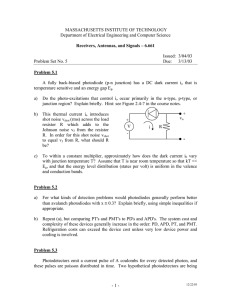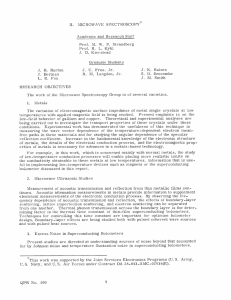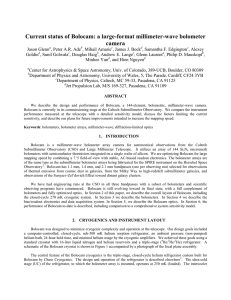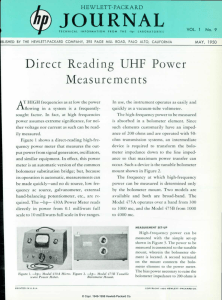GENERAL PHYSICS
advertisement
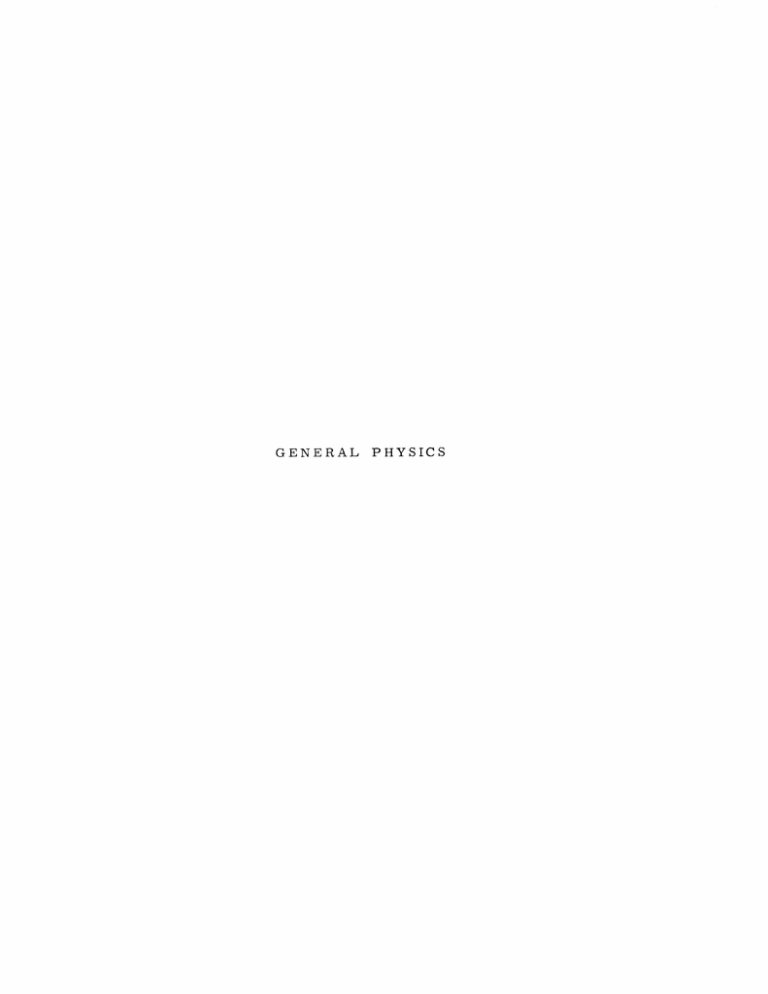
GENERAL PHYSICS I. MICROWAVE SPECTROSCOPY Academic and Research Staff J. G. Ingersoll J. D. Kierstead Prof. M. W. P. Strandberg Dr. S. R. Reznek Graduate Students J. B. Barton L. R. Fox G. C. Rappe B. N. Yung J. U. Free R. M. Langdon, Jr. M. K. Maul A. WORK COMPLETED 1. ELECTRON SPIN RESONANCE ABSORPTION OF PERYLENE This work has been completed by Stephen R. Kutner and submitted as a thesis to the Department of Physics, M. I. T. , August 1968, in partial fulfillment of the requirements for the degree of Bachelor of Science. The ESR spectrum of perylene in sulfuric acid was studied and the "effective" value of the hfs constant for electrons (a+p) is approximately 3. 75 Gauss, and for electron y is approximately 0. 5 Gauss. Relative unpaired electron density for "effective" (a+P) and for y positions are 0. 24 and 0. 0164, respectively. The intensity of the absorption was observed to increase with rising temperature. M. W. P. Strandberg 2. EXCESS NOISE IN SUPERCONDUCTING BOLOMETERS This work has been completed by Michael K. Maul and submitted as a thesis to the Department of Electrical Engineering, M. I. T. , August 1968, in partial fulfillment of the requirements for the degree of Doctor of Philosophy. Two problems in the use of thin-film superconducting bolometers are investigated. These are a source of excess noise in the absence of a magnetic field and the manner in which superconducting bolometer operation differs from that of a conventional bolomThe theory of superconducting bolometer operation is presented and a smallsignal equivalent circuit developed. This circuit contains a portion that represents the dynamic thermal effects and a portion that is due to superconductive phenomena. It is eter. shown that the dynamic impedance is greater than the DC resistance, even for the limit of zero frequency modulation. A peaking phenomena is predicted in the incremental The characteristic impedance versus temperature measurements for this circuit. parameters of bolometer operation are discussed and methods are presented for their *This work was supported by the Joint Services Electronics Programs (U. S. Army, U. S. Navy, and U. S. Air Force) under Contract DA 28-043-AMC-02536(E). QPR No. 91 (I. MICROWAVE SPECTROSCOPY) measurement. Sources of noise in the superconducting bolometer are considered using the fluctuation dissipation theorem. The dominant source of noise is found to be that attributable to unavoidable temperature fluctuations in the bolometer element. A correlation scheme is presented for the detection of low-level noise. Experimental measurements of the dynamic impedance at frequencies from 10 Hz to 3 MHz are found to agree with that predicted on the basis of the small-signal model. Peaking in the impedance versus temperature curves is observed. The bolometer responsivity is found to be bias current and magnetic field-dependent. Average values of the characteristic bolometer parameters are tabled. The observed noise level in zero field is found to be much larger than that expected on the basis of temperature fluctuation noise. This excess noise level is strongly dependent on the applied perpendicular magnetic field, thereby reducing to that predicted on the basis of temperature fluctuations in fields of a few Gauss. consist of 3 components. The spectrum of this noise was measured and found to There is a 1/f 2 component at low frequencies, which is thought to be due to the detection of acoustic noise in bubbling liquid helium. The spectrum for both the excess and thermal noises at frequencies above 50 kHz is constant in magnitude to at least 4 MHz. The low-frequency portion of the spectrum was not effected by the magnetic field, while the excess noise above that of the thermal level was damped by Parallel field measurements indicated that, after the enhancement the magnetic field. in critical field was considered, the noise level was affected in the same manner as in the perpendicular field situation. Pathological behavior of certain films is mentioned. The form of excess noise spectrum is discussed and some suggestions for further investigation offered. M. W. P. Strandberg QPR No. 91
